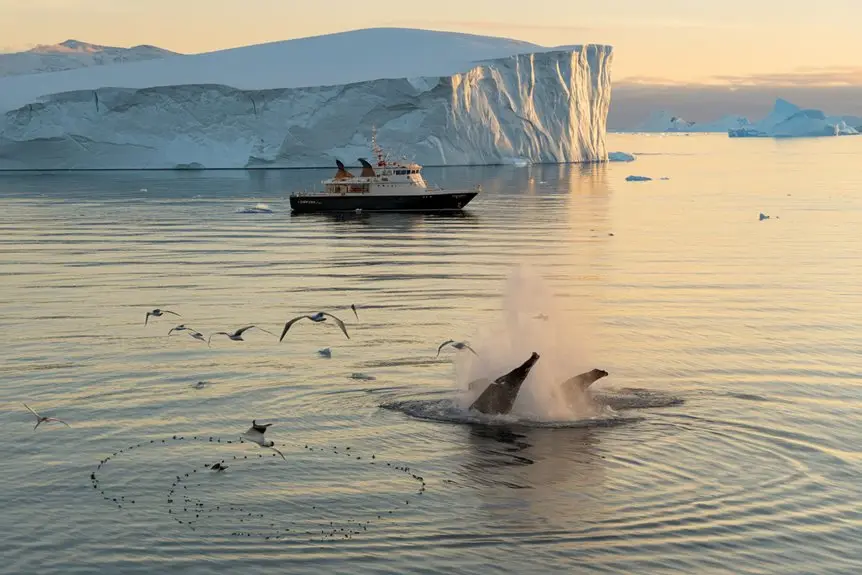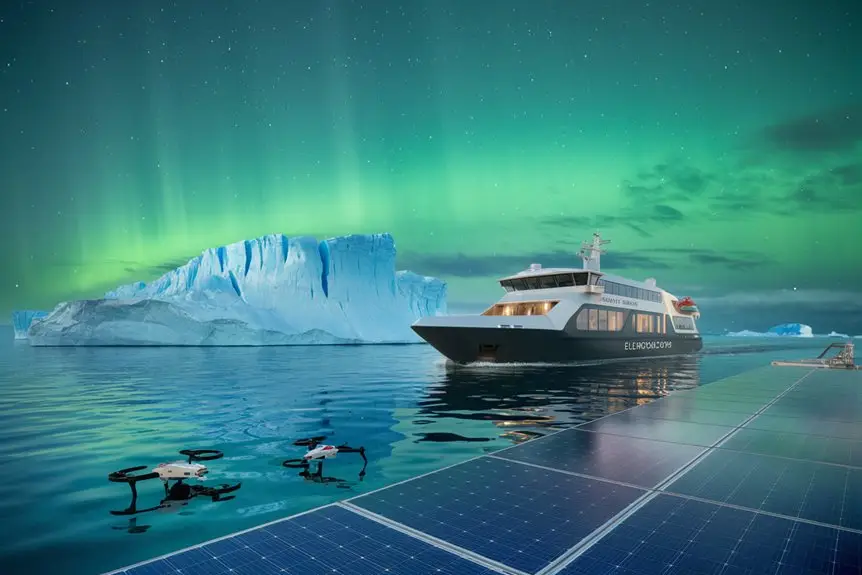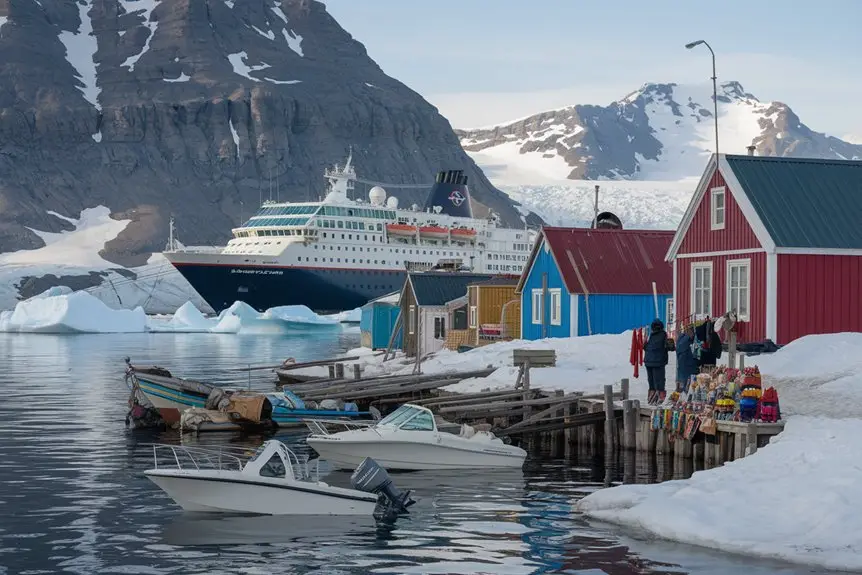While polar cruises might seem brilliant, they come with serious environmental baggage worth thinking about. Each person aboard creates roughly 5.44 tonnes of CO2 – that’s three times more than flying.
For other Polar Cruise destinations check out our Introduction to Polar Expedition Cruises Guide page.
These massive ships churn out loads of waste too – we’re talking about 800,000 litres of sewage every week from just 3,000 passengers. Yes, cruise companies have to follow strict rules about protecting wildlife and keeping their distance from polar bears, but their ships still harm delicate Arctic ecosystems and affect the people who live there.
Some companies are trying to do better by using hybrid-electric ships and clever waste management systems, but let’s be honest – these cruises leave a much bigger environmental mark than most holiday-makers realise.
🐧 Polar Cruise Enquiry 🐻❄️
Our team of polar travel specialists have personally explored both the Arctic and Antarctic regions – from tracking polar bears in Svalbard to kayaking with penguins off the Antarctic Peninsula. Let us find the right polar expedition cruise for you.
Key Takeaways
- These big cruise ships create tons of waste – we’re talking about 800,000 litres of sewage each week from 3,000 passengers, plus loads of dirty water and rubbish.
- When you go on a polar cruise, you’ll put about 5.44 tonnes of CO2 into the air – that’s three times more than if you just took a regular flight.
- Even though cruise ships make up only 1% of all ships worldwide, they pump out 6% of the world’s black carbon emissions.
- The Arctic’s getting warmer and the sea ice is melting away, which means the local wildlife and environment can’t cope well with extra pollution and disruption from tourists.
- Things are getting better though – some new ships use hybrid-electric engines, and there’s this clever MAGS tech that turns waste into energy, so polar cruising isn’t quite as harmful as it used to be.
Waste Management Challenges at Sea

Managing waste on polar cruise ships is a massive headache for the environment. A single ship with 3,000 passengers creates about 800,000 litres of sewage and 400,000 million litres of grey water each week, plus 95,000 litres of oily bilge water and 8 tonnes of solid waste.
These ships produce several types of waste that need sorting properly: oily bilge water, sewage, grey water from daily use, ballast water, and dangerous materials.
All cruise companies must stick to IMO rules and keep proper Garbage Management Plans, but things get trickier in polar areas.
The Arctic Ocean is particularly at risk from microplastic pollution, and sea ice can carry pollutants around, which makes proper waste handling absolutely vital.
Wildlife Protection and Disturbance

Arctic wildlife protection is more important than ever as polar cruise tourism grows, particularly since summer sea ice has dropped by 43% since 1979.
You’ll see strict rules in place to keep wildlife safe, including Svalbard’s rule that ships must stay 500 metres away from polar bears.
To look after at-risk species, cruise companies now need to:
- Get special permits and create detailed trip plans
- Keep passenger numbers to 200 in delicate areas
- Watch and cut down engine noise that affects sea mammal communication
While sailing in polar regions, you’ll spot the clear signs of climate change, with temperatures up nearly 10 degrees Fahrenheit since 1900.
These shifts, plus pressure from tourism, put polar bears, narwhals, and walruses at risk.
That’s why tour companies are working more closely with local wildlife groups and bringing in experts to teach passengers about protecting these animals.
Carbon Footprint of Polar Tourism

Polar cruise tourism leaves quite a hefty carbon footprint, even with attempts to go greener. Each passenger’s journey churns out about 5.44 tonnes of CO2 – that’s roughly three times more than if you just flew the same distance.
What’s rather worrying is that cruise ships release about 0.49 tonnes of CO2 per passenger daily.
The numbers show that 70% of these emissions come from running the ships themselves, whilst the remaining 30% is from passengers flying to and from their homes.
Things get worse because these ships run on high-sulphur heavy fuel oil, leading to more black carbon emissions.
Though cruise ships make up just 1% of ships worldwide, they’re behind 6% of black carbon emissions. This is particularly bad news for polar regions, as these emissions speed up ice melt and mess with the albedo effect (how much sunlight gets reflected back into space).
See what’s on offer from the Arctic vs Antarctic Cruise Experiences for a different Polar Cruise destination.
Sustainable Solutions and Innovations

Polar cruises face real environmental issues, but there’s good news – clever solutions are popping up all over.
Ships are getting better, with companies like Hurtigruten running hybrid-electric vessels that cut carbon emissions by 20%, whilst Quark Expeditions uses their MAGS system to turn waste into power.
The main cruise companies are putting these green practices to work:
- Modern waste handling systems and shore-power links to reduce harm to the environment
- Smart designs like the Ulstein X-bow and LED lights to use less energy
- Working towards zero carbon through teamwork with groups like the Blue Marine Foundation
The rules are quite strict, with IAATO and AECO making sure all expedition staff complete proper training about protecting the environment and wildlife.
All these efforts together are making polar tourism much more sustainable.
These steps are changing how we travel in polar regions, showing that tourism and environmental care can work hand in hand.
Local Communities and Economic Effects

The money side of polar cruises shows a clear divide between who’s making the cash and who isn’t. While big cruise companies rake in loads from trips that cost more than £10,000, the local areas barely see a penny of it. Most holidaymakers keep their spending on the ships rather than in the places they visit.
Up in the Arctic, small Inuit villages often get their daily lives thrown off by cruise ship visitors without getting much money back. These communities don’t have the right facilities to deal with all the tourist rubbish, and they can’t properly benefit from the tourism trade.
It’s a situation where locals have to put up with outsiders disrupting their culture and damaging their environment, while the money goes somewhere else entirely. With polar tourism growing more than 40% compared to before Covid, the gap between what international companies earn and what local people get is getting bigger and bigger.
Frequently Asked Questions
How Do Cruise Ships Navigate Through Ice-Covered Waters Safely?
You want proper training for your crew, good ship prep and keeping an eye on your speed. When going through icy waters, it’s best to stick to marked paths, have someone watching out at all times, and think about getting help from an icebreaker ship to safely make it through the frozen bits.
What Medical Facilities Are Available on Polar Cruise Ships?
There’s a doctor and nurse looking after everyone on board, along with a small medical centre to sort out common health problems and keep serious cases stable until proper help arrives. You’ll find basic medicines and medical kit, though they can’t do any complicated operations or treatments because of space and equipment limits.
How Do Polar Cruises Handle Emergency Evacuations in Remote Regions?
In case of a medical emergency, you’ll be flown out by helicopter or plane. Your required evacuation insurance must cover between £150,000-£400,000, but keep in mind that getting help in these far-flung polar areas can take up to three days.
What Special Training Do Polar Cruise Ship Captains Require?
Polar cruise ship captains need specific skills for sailing in icy regions. You’ve got to learn how to navigate through polar waters, handle ships in ice-packed seas and know what to do in emergencies. Managing your crew and following strict environmental rules is essential. It’s also crucial to be well-versed in specialist equipment and know all about international polar treaties. Plus, you’ll need to be up to speed with cold-weather survival methods.
How Do Cruise Ships Maintain Communication Systems in Extreme Polar Conditions?
You want several ways to keep in touch when you’re sailing in polar regions: IRIDIUM satellites, VHF radios, and spare kit that can handle seriously cold weather. Since normal satellites might not work properly that far north or south, it’s best to regularly look after your gear and give it a proper test beforehand.
Thinking about something different? Check out the Polar Expedition Cruise Features and Benefits.
🐧 Polar Cruise Enquiry 🐻❄️
Our team of polar travel specialists have personally explored both the Arctic and Antarctic regions – from tracking polar bears in Svalbard to kayaking with penguins off the Antarctic Peninsula. Let us find the right polar expedition cruise for you.
